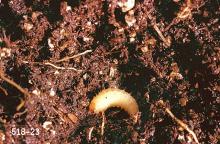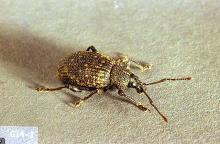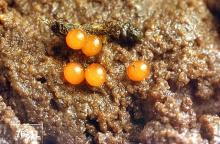Otiorhynchus sulcatus
Pest description and crop damage The flightless adult has a roughened hard-shelled appearance and is 0.5 inch in length. Adult beetles are black with small patches of white scales on the forewings. The front of the head projects forward into a lengthened snout-like structure. Adults feed on foliage and inflorescence or cluster stems (rachis), especially just before unfertilized berries drop shortly after bloom. Berry and cluster stems can be girdled. Feeding may damage or destroy primary buds and new shoots in early spring. Larvae or grubs feed on the roots of the vine but cause no apparent damage. Black vine weevil can be a serious problem, especially in nurseries or newly established vineyards, but damage is usually sporadic.
Biology and life history Black vine weevils overwinter as larvae in the soil. Larvae pupate during April and adult beetles emerge in May and June. Black vine weevil females lay their eggs in the soil about 2 to 3 weeks after emergence for 6 to 8 weeks. A single female may lay 500 eggs.
Sampling and thresholds Monitor adults with cardboard traps. Wrap corrugated cardboard around vine trunks that have loose bark removed. During the day, adults hide between the wrap's corrugations and the smooth trunk. The cardboard traps can be removed and inspected to determine presence of the pest. No information is available on threshold levels.
Management-biological control
Little is known about biological control, but it is estimated that many larvae fall prey to predatory beetles, entomopathogenic fungi, and nematodes.
Management-cultural control
Cultivation around the base of vines in spring (April) may kill some pupae.
Management-chemical control: HOME USE
- cyfluthrin
- insecticidal soap
- spinosad-Some formulations are OMRI-listed for organic use.
Management-chemical control: COMMERCIAL USE
- azadirachtin (Aza-Direct, Neemix 4.5 and other brands)-Rate varies with specific product; consult label for the correct rate. Apply foliar sprays to control adult feeding, and soil drench for larval stage. Some formulations are OMRI-listed for organic use. Neemix is registered for use in Washington and Idaho; it is not registered for use in Oregon.
- bifenthrin (Brigade 2EC and other products) at 0.1 lb ai/A. Good coverage is essential for control. Apply with a minimum of 25 gal water per acre to ensure good coverage. PHI 30 days. Group 3A insecticide. Restricted use pesticide.




